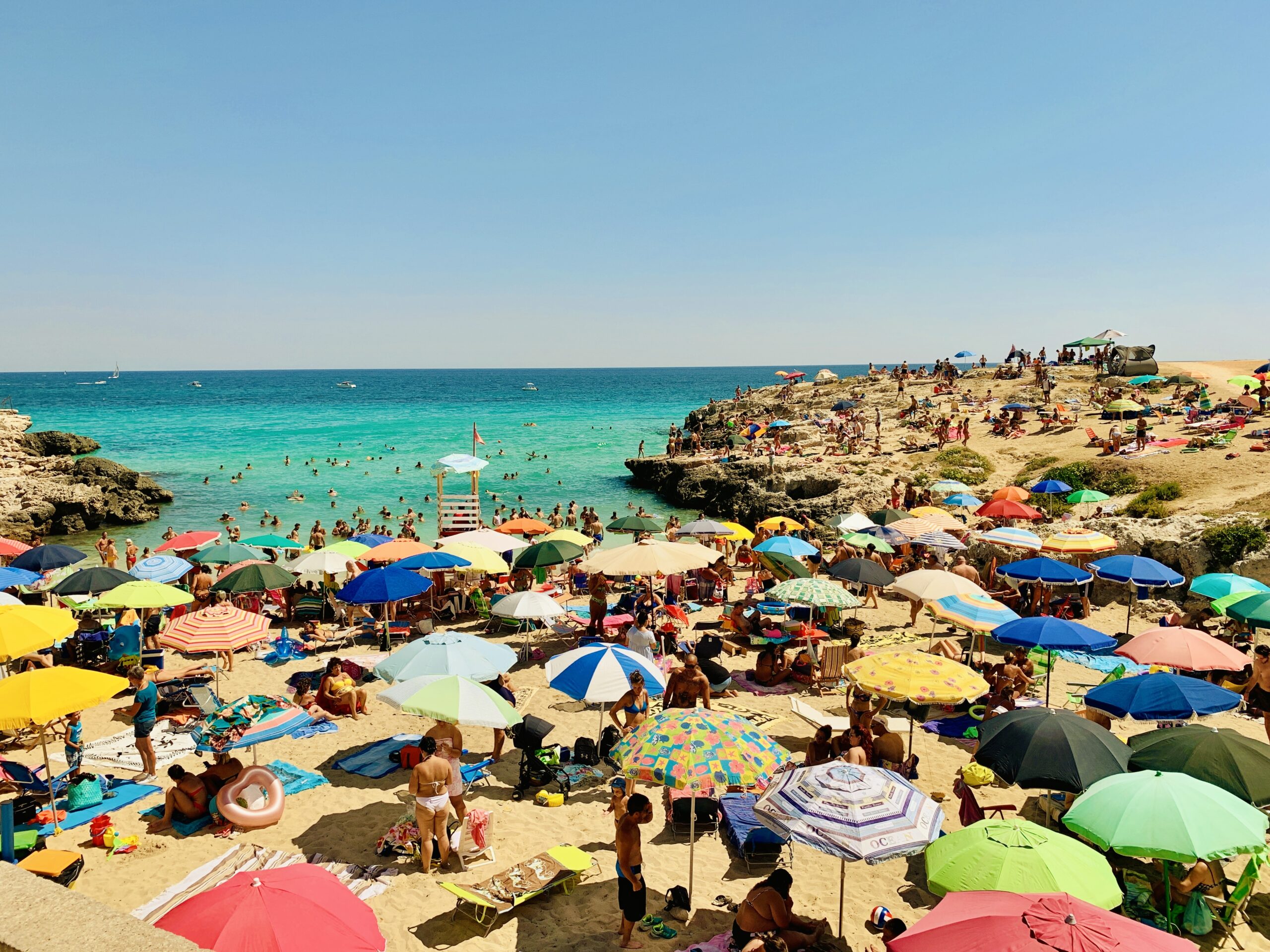Is Puglia A Region at Risk of Being Consumed?
Puglia is certainly having its moment. Long loved by Italians and Europeans for its beaches, food, and timeless rhythms, this region of southern Italy is now being “discovered“ by a growing wave of American travellers, attracted by its authenticity, slow pace and Mediterranean beauty.
We wrote about over-tourism in Puglia for the February edition of Amazing Puglia Magazine. With the summer season well and truly here, Puglia has been shocked by the explosion of tourists visiting our region from the USA. Puglia – once overlooked by American travellers in favour of the “holy trinity” of Rome, Florence and Venice, or more recently, Naples and Sicily – has been rebranded in the US press as a hidden gem. With direct flights from New York’s JFK Airport to Puglia, American tourists are everywhere we look. And it’s changing the nature of tourism.
Unlike European visitors, or those from the southern hemisphere, tourists from the USA arrive with expectations often unmatched to the reality of travel in Puglia and Southern Italy more broadly. Our region asks for something that not every US tourist is prepared for: cultural adaptation. This region doesn’t work like home, and that’s the point.
But this isn’t just about cultural differences. As Puglia becomes more visible on the global tourism map, it’s also becoming more vulnerable – to overdevelopment, to environmental pressure, and to the commodification of its culture and landscape. The rise in luxury tourism, mega-resorts, and Instagram-driven experiences risks eroding the very qualities that made Puglia special in the first place. What began as a grassroots revival of local identity is now being recast as curated spectacle.
So what’s the cost of success? Is Puglia’s transformation into a luxury destination reshaping its landscape, displacing local communities, and turning a once-authentic region into a consumable product designed for external audiences?
The Other Side of Paradise: How Luxury Tourism is Transforming Puglia
For many, Puglia evokes a dreamscape: whitewashed hill towns, sun-bleached trulli, crystalline seas, and olive groves stretching to the horizon. It’s a region that seems timeless – yet the Puglia seen on postcards and Instagram feeds is not as ancient or authentic as it appears. Behind the curated aesthetic of luxury weddings, mega-resorts, and influencer-led travel campaigns lies a more complex story: one of environmental degradation, cultural distortion, and the quiet erasure of the region’s rural soul.
A Long Road to Reinvention
Tourism in Puglia is not a recent phenomenon. Its roots stretch back to the late 19th century, when aristocrats and elites would retreat to coastal villas and thermal spas. In the post-war decades, mass tourism reshaped the coastline, with sprawling seaside resorts and gated holiday villages built to accommodate the boom in domestic beach holidays. Often, these developments came at the cost of the very landscapes that made the region attractive in the first place – wetlands drained, dunes bulldozed, olive groves uprooted.
By the 1990s, the spotlight turned inland. Tourists seeking more ‘authentic’ experiences discovered the charm of the Valle d’Itria and rural Puglia. Abandoned farmhouses and crumbling masserie were restored – sometimes sensitively, often not – and transformed into boutique hotels and agriturismi. While this shift brought economic opportunities, it also introduced a new wave of rural gentrification. Local families were priced out of the land they had worked for generations, replaced by outsiders with the capital to convert heritage into lifestyle.
The Rise of Disconnected Luxury
In recent years, the rise of luxury tourism has taken a different turn. Entire artificial “villages” have been built from scratch to mimic the look and feel of historic centres, complete with uniform stonework, manicured olive trees, and staff in period-style uniforms. Vast resorts with private beaches and gated perimeters promise curated tranquility, while golf courses and spas cater to the demands of high-net-worth travellers. These developments, while glossy on the surface, often form part of a parallel reality – one that is almost entirely disconnected from the communities around them.
The costs are more than cultural. Golf courses and luxury estates consume staggering amounts of water, in a region already highly vulnerable to drought, desertification, and the broader impacts of climate change. The unchecked expansion of tourism infrastructure – frequently supported by fast-tracked public funds and bypassing environmental impact assessments – has led to irreversible damage to fragile ecosystems.
Last summer the influx of tourists during caused repeated blackouts due to overloaded electricity grids in the Valle d’Itria, where poorer families are priced out of their homes in some of the most popular towns.
Rebranding Identity for Consumption
Puglia’s image has been meticulously rebranded for a global market. The region is now promoted not as a living, working land, but as a lifestyle product: a backdrop for destination weddings, Instagram shoots, and aspirational travel. Trulli, once humble agricultural shelters, are now luxury accommodations. Masserie, once centres of collective rural labour, are reimagined as exclusive retreats. Local festivals, like the Notte della Taranta, which once marked a cultural revival of regional identity, have been co-opted into the tourist spectacle.
Even the rhythms of daily life have been adjusted to fit tourist expectations. Locals find themselves catering to curated versions of their own traditions, with little space left for the ordinary, messy, and meaningful realities of rural existence.
Who Benefits?
Despite the economic growth tied to tourism, the benefits are unevenly distributed. Many luxury properties are foreign-owned, profits extracted rather than reinvested. Jobs created are often seasonal and precarious. Meanwhile, younger Puglians struggle to find housing in their own towns, as short-term holiday rentals and investment properties drive up prices.
What is lost is not just landscape or tradition, but a way of life. When entire communities are shaped around the desires of outsiders, the essence of place becomes diluted. The region risks becoming a consumable façade – picturesque but hollow.
Rethinking the Future
Puglia doesn’t need to turn its back on tourism. But it does need to ask: What kind of tourism? For whom? At what cost? Real sustainability requires more than recycled olive oil bottles and EV charging stations at resorts. It means protecting landscapes from overdevelopment, supporting local producers and artisans, and ensuring that tourism complements rather than replaces everyday life.
For visitors, the responsibility is just as great. Seek out the places where locals still live. Stay in family-run accommodations. Support community festivals not for their spectacle, but for their roots. And above all, look beyond the filter – to discover not just the beauty of Puglia, but its depth.



